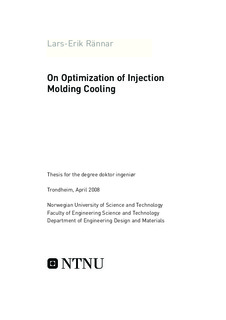| dc.description.abstract | This thesis is devoted to analysis and optimization of the injection molding process with a focus on the mold. In the analysis, both process parameters and the design of the mold are taken in consideration. A procedure has been developed, i.e. a method and a program code, which enables optimization of different quantities, not only restricted to injection molding simulation, by altering different variables. There are many ways to interpret the word “optimization”. In this work, “optimization” means the use of mathematical algorithms in order to maximize or minimize any given quantity. This code, called VerOpt, is written in Matlab. It is versatile since it has the functionality of choosing different optimization routines, and it can make use of parallelization over TCP/IP and different external solvers. The software and different applications are further described in Paper A.
There is a pocketful of softwares on the commercial market today, which enables the analysis of the injection molding process. One example is the software Moldex3D by Coretech System. By using simulation in the product development process, much can be gained since the software allows one to make most of the tedious and cost-consuming trial-and-errors in the virtual world, instead of on the shop floor. In Paper B, Moldex3D is used in order to compare the efficiency, in terms of the dimensional accuracy, between two different cooling channel layouts. One conventional layout uses straight holes and a baffle, and another layout makes use of conformal cooling channels manufactured by Free-Form Fabrication (FFF). In Paper C, a comparative study is presented where numerical results are compared with corresponding experimental results using these two types of cooling channel design. For the FFF layout, the Electron Beam Melting (EBM) method was used to manufacture the core insert to the mold. In Paper D, the surface heat distribution of conventional and FFF inserts was investigated, and the influence of the coolant temperature on the surface of the insert was studied.
FFF, or Rapid Prototyping (RP), has been commercially available since the late eighties, but the method is not that well known within the injection molding industry. The first available material was plastics. Today, FFF has evolved and fully dense forms in different metal alloys can be manufactured which are suitable for mold inserts. Studies have shown that by using FFF mold inserts in injection molding, both that the part quality can be increased and that the costs for manufacturing the insert can be decreased. The effects of different process parameters on the warpage of a plastic part are however rather complicated and the introduction of new types of inserts manufactured by FFF makes these effects even harder to predict. In Paper E, Design of Experiments (DOE) is used in order to investigate the influence of different process parameter on the critical dimensional accuracy of a test part. The same part was used for two different studies: one using conventional cooling and the other one using an FFF layout.
In Paper F, four process parameters were chosen after considering the results obtained from the DOE in Paper E, as variables in an optimization study where the warpage of the test part was minimized using the VerOpt code. In order to measure the efficiency of the FFF mold insert, the optimization was performed on the conventional layout as well.
In conclusion, this work has demonstrated the feasibility of including a versatile optimization environment to a commercial injection molding software, and it has also pointed out some important differences in the influence of different process parameters on the warpage of a plastic part when conventional and FFF cooling channel layouts are used. | nb_NO |
